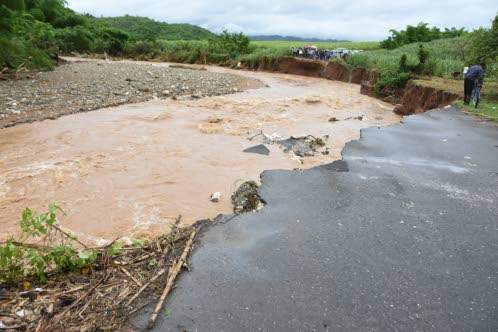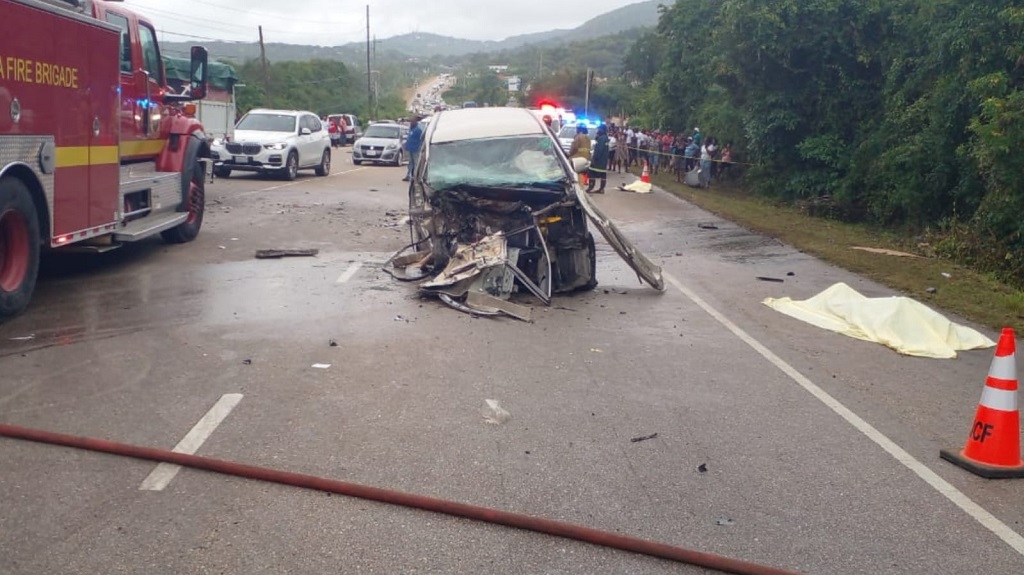The Government says it is too early to give an estimate, but the cost to the country from relentless rains over the past three days could be staggering, considering that the damage from showers just a few weeks ago was preliminarily put at close to $500 million.
It was only on Monday that the local government ministry allocated $175 million in emergency funds to six parishes to help restore access to communities which were cut off as a result of those rains.
And now, three days of heavy rains associated with a trough across the central Caribbean have again wreaked havoc on the island’s infrastructure, dumping up to a month’s volume of rainfall on some areas, washing away bridges, tearing up roads, forcing rivers to burst their banks, and leaving a number of Jamaicans marooned.
While there were no reports of deaths up to yesterday evening, more than 30 people have so far had to be rescued by the Jamaica Defence Force and the Jamaica Fire Brigade.
The Office of Disaster Preparedness and Emergency Management (ODPEM) says the community of Aenon Town in Clarendon — the hardest hit parish — was inundated by up to 17 feet of raging waters.
Flood waters also converted the Guy’s Hill main road in St Catherine into a river.
Yesterday, at a Jamaica House press conference, Acting Prime Minister Dr Horace Chang said St Thomas, Kingston, St Andrew, St Catherine, Manchester, parts of Westmoreland, St Mary, Portland, and sections of northern St Ann were also severely impacted.
“The volume of rainfall over the last 24 hours (between Monday and Tuesday), in particular, has caused severe infrastructural and agricultural damage, dislocation, and major inconvenience, especially for students who are sitting secondary exit exams. The reports have been coming in fast from Westmoreland to St Thomas and Trelawny to Portland of inundated roads and farmlands, lost crops, flooded communities, breakaways and landslides, and citizens who have been marooned or were in distress,” Dr Chang stated.
In the meantime, Local Government Minister Desmond McKenzie said the parishes of St James, Trelawny, and Hanover were the only ones spared the wrath of the relentless rains.
The National Works Agency (NWA) reported extensive flooding in southern Clarendon in areas such as Sedge Pond, Water Lane, Foga Road, McGilchrist Pen, and Four Paths. Also, the Green River Bridge, which gives access to Frankfield, as well as the Dam Head Bridge, have been washed away, the authorities reported. Major landslides have occurred in communities in the parish, blocking roads, such as that which joins Danks to Croft’s Hill. A long list of other roads have all been impacted by landslides.
With the Bog Walk Gorge flooded, the NWA has asked that motorists either go through Sligoville or use the North-South link of Highway 2000, as the other alternative route, through Barry, was impassable.
In rural St Andrew, there were two massive landslides, at Flamstead and Milepost 16 in Newcastle, while in Mammee Bay, St Ann, and parts of Mandeville, Manchester, there were reports of flooding. Westmoreland, though not as severely impacted, has also experienced flooding in Little London and a number of other communities.
“It’s too early to contemplate the issue of fiscal impact; the works agency is carrying out a detailed analysis and we do have some contingency funding in the budget, and we stand ready to assist,” Finance Minister Audley Shaw said yesterday.
Dr Chang, meanwhile, said on Friday morning the Government will seek a further comprehensive assessment of the damage, stressing that “the impact of the adverse weather is clear”.
Yesterday, director of the Meteorological Service Division Evan Thompson said Jamaica was not out of the woods yet. “The peak of the rainfall for this event we are expecting has passed, [as] most of the activity has started to move off the island. However, we are still in the general area of that trough, and it is interacting with a frontal system that is more towards the north,” he said.
“So we do expect that for the next 24 hours, first of all, we will see a decrease in the rainfall towards more in the vein of what we experienced in the 24 hours preceding this one. As we move towards Thursday, we should see even less,” he explained.
Meanwhile, the ODPEM has activated the National Emergency Operations Centre and shelter managers were on standby with orders to respond to evacuations, and parish emergency operation centres have also been activated.
McKenzie said his ministry was working with the Ministry of Labour and Social Security and other State agencies to ensure that affected individuals receive assistance. Eleven shelters were opened in Clarendon and St Catherine, but none were occupied up to last evening.
April/May is the secondary rainy season, while the Atlantic Hurricane Season starts on June 1 and runs until November 30










